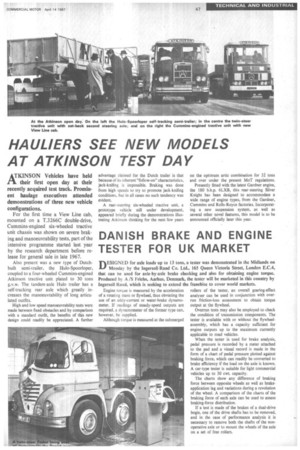DANISH BRAKE AND ENGINE TESTER FOR UK MARKET
Page 49

If you've noticed an error in this article please click here to report it so we can fix it.
DESIGNED for axle loads up to 13 tons, a tester was demonstrated in the Midlands on Monday by the Ingersoll-Rand Co. Ltd., 165 Queen Victoria Street, London E.C.4, that can be used for axle-by-axle brake checking and also for obtaining engine torque. Produced by A IS Frichs, Aarhus, Denmark, the tester will be marketed in this country by Ingersoll-Rand, which is seeking to extend the franchise to cover world markets.
Engine torque is measured by the acceleration of a rotating mass or flywheel, thus obviating the use of an eddy-current or water-brake dynamometer. If readings of steady-speed outputs are required, a dynamometer of the former type can, however, be supplied.
Although torque is measured at the submerged rollers of the tester, an overall gearing-effect analyser can be used in conjunction with overrun friction-loss assessment to obtain torque output at the flywheel.
Overrun tests may also be employed to check the condition of transmission components. The tester is available with or without the flywheelassembly, which has a capacity sufficient for engine outputs up to the maximum currently applicable to road vehicles.
When the tester is used for brake analysis, pedal pressure is recorded by a meter attached to the pad and a visual record is made in the form of a chart of pedal pressure plotted against braking force, which can readily be converted to brake efficiency if the load on the axle is known. A car-type tester is suitable for light commercial vehicles up to 30 cwt. capacity.
The charts show any difference of braking force between opposite wheels as well as brakeapplication lag and variations during a revolution of the wheel. A comparison of the charts of the braking force of each axle can be used to assess braking-force distribution.
If a test is made of the brakes of a dual-drive bogie, one of the drive shafts has to be removed, and in the case of performance analysis it is necessary to remove both the shafts of the nonoperative axle or to mount the wheels of the axle on a •set of free rollers.
























































































































